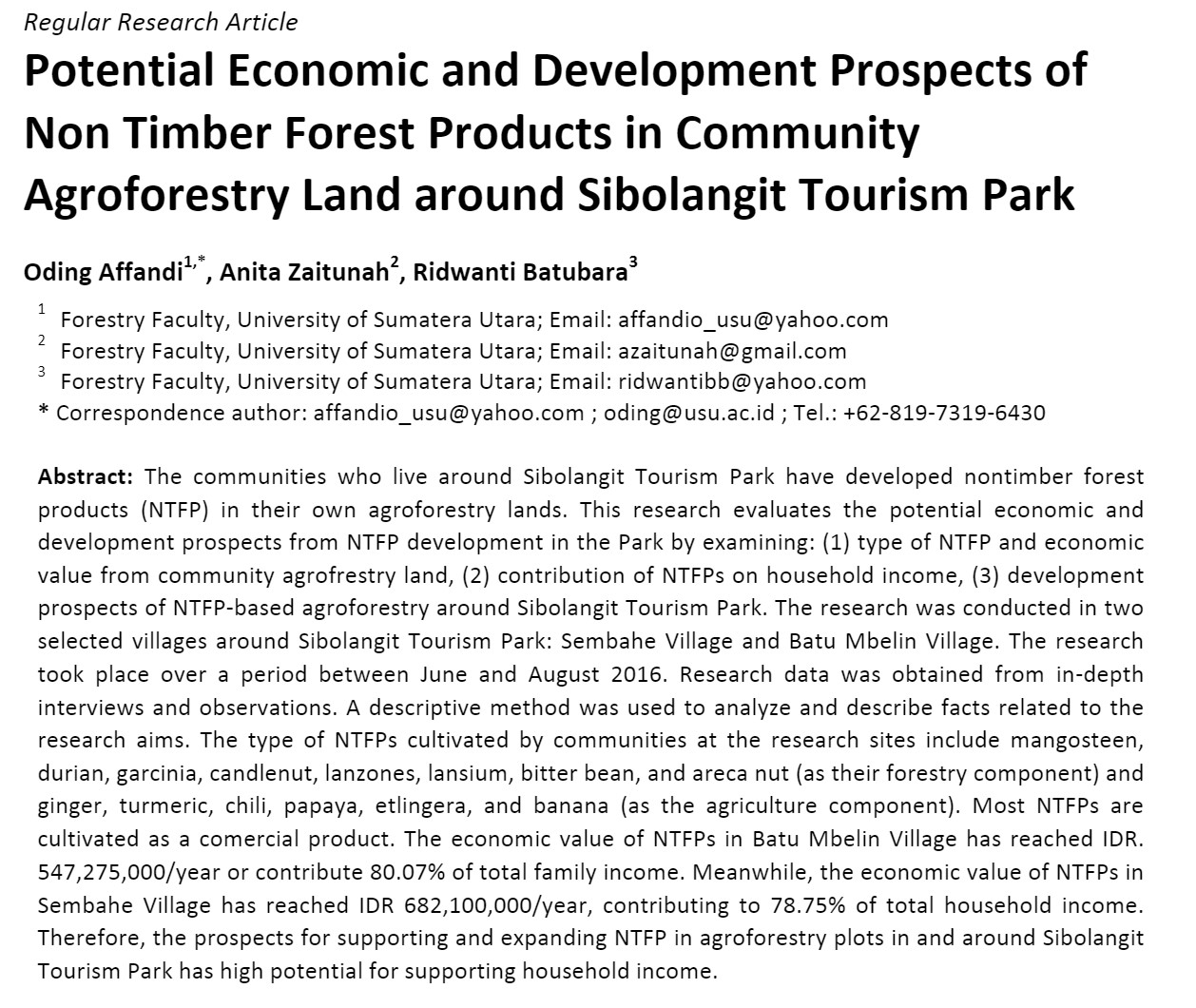Potential Economic and Development Prospects of Non Timber Forest Products in Community Agroforestry Land around Sibolangit Tourism Park
Versions
- 2017-04-27 (2)
- 2017-04-27 (1)

Additional Files
The communities who live around Sibolangit Tourism Park have developed nontimber forest products (NTFP) in their own agroforestry lands. This research evaluates the potential economic and development prospects from NTFP development in the Park by examining: (1) type of NTFP and economic value from community agrofrestry land, (2) contribution of NTFPs on household income, (3) development prospects of NTFP-based agroforestry around Sibolangit Tourism Park. The research was conducted in two selected villages around Sibolangit Tourism Park: Sembahe Village and Batu Mbelin Village. The research took place over a period between June and August 2016. Research data was obtained from in-depth interviews and observations. A descriptive method was used to analyze and describe facts related to the research aims. The type of NTFPs cultivated by communities at the research sites include mangosteen, durian, garcinia, candlenut, lanzones, lansium, bitter bean, and areca nut (as their forestry component) and ginger, turmeric, chili, papaya, etlingera, and banana (as the agriculture component). Most NTFPs are cultivated as a comercial product. The economic value of NTFPs in Batu Mbelin Village has reached Rp. 547,275,000/year or contribute 80.07% of total family income. Meanwhile, the economic value of NTFPs in Sembahe Village has reached Rp 682,100,000/year, contributing to 78.75% of total household income. Therefore, the prospects for supporting and expanding NTFP in agroforestry plots in and around Sibolangit Tourism Park has high potential for supporting household income
Affandi, O. and Siregar, E.B.M. (2010). Reba Juma: Kelestarian Praktek Agroforestry Lokal pada Masyarakat Karo, Propinsi Sumatera Utara. AGRICA. Jurnal Agribisnis Sumatera Utara. 3 (1): 1-11
Andayani, W. (2015). Strategi Penetapan Harga And Pengembangan Pemasaran Hasil Hutan Bukan Kayu (HHBK) Dalam Rangka Meningkatan Pendapatan Sektor Kehutanan. Prosiding Seminar Nasional “Peranan dan Strategi Kebijakan Pemanfaatan Hasil Hutan Bukan Kayu (HHBK) Dalam Meningkatkan Daya Guna Kawasan Hutan, 6-7 November 2014, Fakultas Kehutanan Universitas Gadjah Mada. Yogyakarta
Arikunto, S. (2006). Prosedur Penelitian. Penerbit Rineka Cipta. Edition VI. Jakarta.
Awang, S.A., Andayani, W. Himmah, B. Widayanti, W.T. and Affianto, A. (2002). Hutan Rakyat Sosial Ekonomi dan Pemasaran. BPFE- Yogyakarta. Yogyakarta.
de Foresta, H., Kusworo, A., Michon, G., & Djatmiko, W. A. (2000). Ketika kebun berupa hutan: Agroforest khas Indonesia sebuah sumbangan masyarakat. Institut de Recherche pour le Development (IRD) and International Centre for Research in Agroforestry (ICRAF). Bogor.
Djajapertjunda, S. (2001). Studi Kolaborasi Pengelolaan Repong Dama Kruing Lampung. Syafa’at Advertesing and Forum Komunikasi Kehutanan Masyarakat.
Hairiah, K., Sardjono, M.A. and Sabarnurdin, S. (2003). Bahan Ajar 2. Pengantar Agroforestry. World Agroforestry Center (ICRAF). Bogor
Indriyanto. (2008). Silvikultur Pada Sistem Wanatani. Pengantar Cultivation Hutan. PT Bumi Aksara. Jakarta
Ngakan, P. O., Komarudin, H., Achmad, A., & Wahyudi, T. (2006). Ketergantungan, persepsi dan partisipasi masyarakat terhadap sumberdaya hayati hutan: studi kasus di dusun Pampli kabupaten Luwu utara, Sulawesi selatan. Center for International Forestry Research (CIFOR). Bogor
Nurapriyanto, I., Tuharea, A., & Arifin, N. (2003). Sistem Pengusahaan Beberapa Hasil Hutan Bukan Kayu dan Alur Tataniaganya di Jayapura, Papua. Penelitian Sosial Ekonomi dan Kebijakan Kehutanan. Jayapura.
Qosim, W. A. (2013). Pengembangan Buah Manggis sebagai Komoditas Ekspor Indonesia. Jurnal Kultivasi. Fakultas Pertanian Universitas Padjadjaran, 12, 40-45.
Sardjono, M.A., T. Djogo, H.S. Arifin, and N. Wijayanto. (2003). Bahan Ajaran 2. Klasifikasi and Pola Kombinasi Komponen Agroforestry. World Agroforestry Center (ICRAF). Bogor
Setiawan, A. (2014). Analisis Sosial Ekonomi Pola Agroforestri Di Sub Das Lahumbuti Kabupaten Konawe Propinsi Sulawesi Tenggara. Thesis. Universitas Hasanuddin. Makasar.
Suhardjito, D., Khan, A. Djatmiko, W.A. Sirait, M.T. and Evelyna, S. (2000). Karakteristik Pengelolaan Hutan Berbasiskan Masyarakat. Aditya Media. Yogyakarta
Widiarti, A., & Prajadinata, S. (2016). Karakteristik hutan rakyat pola kebun campuran. Jurnal Penelitian Hutan dan Konservasi Alam, 5(2), 145-156.
Widiyanto, A. 2013. Beberapa Catatan Mengenai Hasil Hutan dalam Sistem Agroforestry. Retrieved from https://www.researchgate.net/publication/299980458
Copyright (c) 2019 Forest and Society

This work is licensed under a Creative Commons Attribution 4.0 International License.
This is an open access journal which means that all contents is freely available without charge to the user or his/her institution. Users are allowed to read, download, copy, distribute, print, search, or link to the full texts of the articles in this journal without asking prior permission from the publisher or the author. This is in accordance with the BOAI definition of open access.
Submission of an article implies that the work described has not been published previously (except in the form of an abstract or as part of a published lecture or academic thesis), that it is not under consideration for publication elsewhere, that its publication is approved by all authors and tacitly or explicitly by the responsible authorities where the work was carried out, and that, if accepted, will not be published elsewhere in the same form, in English or in any other language, without the written consent of the Publisher. An article based on a section from a completed graduate dissertation may be published in Forest and Society, but only if this is allowed by author's(s') university rules. The Editors reserve the right to edit or otherwise alter all contributions, but authors will receive proofs for approval before publication.
Forest and Society operates a CC-BY 4.0 © license for journal papers. Copyright remains with the author, but Forest and Society is licensed to publish the paper, and the author agrees to make the article available with the CC-BY 4.0 license. Reproduction as another journal article in whole or in part would be plagiarism. Forest and Society reserves all rights except those granted in this copyright notice







